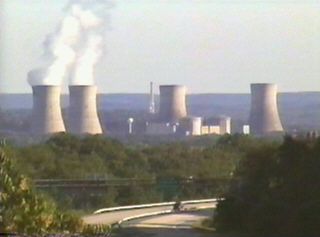
Security problems at US nuclear plants were first
uncovered in 1975, right here at Three Mile Island
|
This site describes the threat of sabotage and terrorism to nuclear power plants with a special focus on securing Three Mile Island.
|
| Considering the fact that a nuclear plant houses more than a thousand times the radiation as released in an atomic bomb blast, the magnitude of a single attack could reach beyond 100,000 deaths and the immediate loss of tens of billions of dollars. The land and properties destroyed (your insurance won't cover nuclear disasters) would remain useless for decades and would become a stark monument reminding the world of the terrorists' ideology. With more than 100 reactors in the United States alone, if one is successfully destroyed, just threatening additional attacks could instill the sort of high impact terror which is being sought by a new breed of terrorists. |  |
Security Incidents at TMI
|
In the spring of 1975, two conscientious security guards revealed to the nation just how poor security was at TMI in an effort to remedy the problems.
John Darcy and Joe Shapiro initially raised the issue with their bosses who not only ignored their concerns, but pressured the pair to resign by telling
them that they could not be assured of their safety when returning to work. The veiled threat forced the two to seek help elsewhere. Darcy and Shapiro held a press conference in Washington D.C. with Ralph Nader. Nader called nuclear plant security a "sham" and a threat to national security. Nader called for a congressional investigation. Two years later, the Government Accounting Office agreed with the guards and said security was "inadequate at best." One chapter of the report was titled "Why has the NRC's Security Program Failed."
--- One quarter of all vehicle intrusions at U.S. nuclear plants have occurred at TMI. A previous intrusion at TMI in 1976 was somewhat comical. As if to laugh in the face of security, an intruder drove onto the site, climbed an unalarmed fence and seemingly disappeared. About 35 minutes later he was heard singing from atop the reactor building! Searches were conducted but the individual was not found.
--- Following the 1979 partial meltdown at TMI, investigators became suspicious of sabotage. Paul Leventhal, co-director of the US Senate investigation of the Three Mile Island accident, wanted to perform a special sabotage investigation. "The initiating event was always so mysterious in that so little was known about it," Leventhal said in an interview. "I wanted to hire someone like a former FBI agent to do an investigation but the Minority co-director objected." The President's Commission investigators also became suspicious and asked to examine the licensees personnel files for "any person who might have long-standing grievances against the company." This was requested specifically as an attempt to discover workers who might have had incentive to close the emergency feedwater valves. Interrogation of the five workers who were identified by the company was considered but never performed. Soon after the 1979 emergency, the Los Alamos Scientific Laboratory concluded:
--- And an embarrassing incident did happen several months after the partial meltdown when a newspaper reporter was hired as a security guard. He told of entering the control room unchallenged (only armed guards were permitted access). There was no lock on the door and a piece of clothesline hung where the doorknob should have been. A college textbook used this incident as an example of poor security. The book cited the reporter's headline -- "Three Mile Island: It's a Paradise Island for the Saboteur." General Public Utilities sought an injunction to block publication of the article on the grounds that it could compromise national security.
Another emergency at the Three Mile Island (TMI) Nuclear Generating Station on February 7, 1993 demonstrated security weaknesses at US nuclear plants. Operators declared the highest level of emergency since the accident when an intruder was loose in the plant. Reactor Unit 1 was operating at full power. Shutting it down would require workers to manipulate equipment from outside the locked control room and thereby place them in jeopardy of becoming hostages. A hostage situation could raise the threat level to unthinkable scenarios where operators would have to make decisions on their buddies' lives. If the car or the intruder is armed with explosives, a catastrophic radiological release may be hours or even minutes away. Many people living near TMI re-experienced old familiar fears and even traumas that they had been trying to forget. A family about to return from a vacation called their neighbors to see if it was safe to come home. Something as frightening as a nuclear disaster can vex the soul for a long time.
Four hours later the intruder was found curled up in a fetal position and seemed unaware of his surroundings. He was arrested, charged with four felonies including "risking a catastrophe" and then hospitalized for psychiatric observation. The intruder was not hostile and the only damage to plant systems resulted from the car's striking equipment in a place and manner which did not directly threaten public safety.
|
JUMPING TO CONCLUSIONS Unbelievably, the IIT concluded that GPUN had responded appropriately. How could they make this claim? They simply add the phrase, "to the specific challenges presented by the intruder." At the April 6, 1993 briefing of the NRC commissioners by the IIT, Commission Chairman Ivan Selin volunteered that security had not faced a difficult test. Selin said, "The fact was this guy, wasn't hostile, he wasn't armed and he didn't do anything. So, almost anything that they would have done would have been appropriate in that sense, and there would not have been radiological damage, et cetera." But, Selin wanted to know if thoughtful decisions had been made or if GPUN just did things that "turned out okay." Team leader Sam Collins replied, "My opinion of that would be, we didn't directly address that in the report."
Another NRC analysis of the incident concluded:
|
![[IMAGE]](routee.jpg) He exited the car, descended a ladder and hid in the darkened belly of
the condenser pit. It was so dark that guards put off performing a thorough search until brighter
flashlights were made available. In the meantime, the plant continued operating at full power
while the control room staff carefully watched the gauges and alarms for any changes that would
indicate sabotage.
He exited the car, descended a ladder and hid in the darkened belly of
the condenser pit. It was so dark that guards put off performing a thorough search until brighter
flashlights were made available. In the meantime, the plant continued operating at full power
while the control room staff carefully watched the gauges and alarms for any changes that would
indicate sabotage. ![[IMAGE]](turbine.jpg)